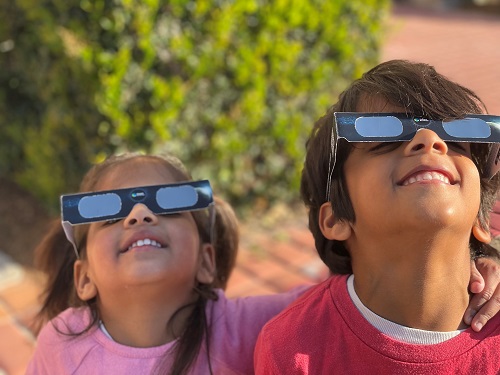Partial and total solar eclipses occur relatively often in different parts of the world. To help you make the most out of this unique celestial event, we’ve compiled a simple eclipse checklist. We wish everyone a happy and unforgettable eclipse viewing day.
Solar Eclipse Checklist
Before the Eclipse
-
- Learn About the Eclipse: Knowing when and how the eclipse will occur will enhance your experience.
- Choose a Viewing Location: Find a spot with a clear view of the sky and minimal light pollution. If the eclipse isn’t fully visible from your location, consider traveling to a place within the path of totality.
- Make Sure You’ve Allocated Enough Time for Travel: If you are driving to a popular viewing location, traffic may be very heavy on the day of the eclipse.
- Check the Weather: Clear skies are crucial for eclipse viewing. Check the forecast and have a backup plan if necessary. Live video of the event is a safe bet for watching a total eclipse.
- Have a Plan to Protect Your Eyes: Obtain ISO-certified solar viewing glasses to safely watch the eclipse. Regular sunglasses are not safe for viewing the sun. You can also use an indirect viewing method such as a simple pinhole projector to avoid looking directly at the sun. If you are watching the partial eclipse, you must protect your eyes during the entire event. In the path of totality, it is safe to look at the sun directly without protection only during totality when the moon completely covers the sun. Find out more.
- Plan Ahead if You Plan to Photograph or Record the Eclipse: Astrophotographer Jon Carmichael has tips for safely photographing an eclipse with a DSLR or smart phone.
During the Eclipse
- Protect Your Eyes: Safety first! Always wear solar eclipse glasses when looking directly at the sun, except during the totality phase of a total solar eclipse when the sun is completely covered. Alternatively, use an indirect viewing method such as a pinhole projector.
- Monitor the Time: Be aware of the timing for the different phases of the eclipse in different locations so you don’t miss any important moments.
- Be Prepared to Safely Photograph the Eclipse: If you plan to photograph the eclipse, protect your eyes and equipment. There will be plenty of great photos available, so don’t miss out on the eclipse by focusing on your smart phone or camera.
- Observe Changes: Notice the environmental changes around you as the eclipse progresses, such as temperature drops and changes in animal behavior.
- Have Fun and Enjoy the Moment: There won’t be another total solar eclipse in the U.S. until 2044.

